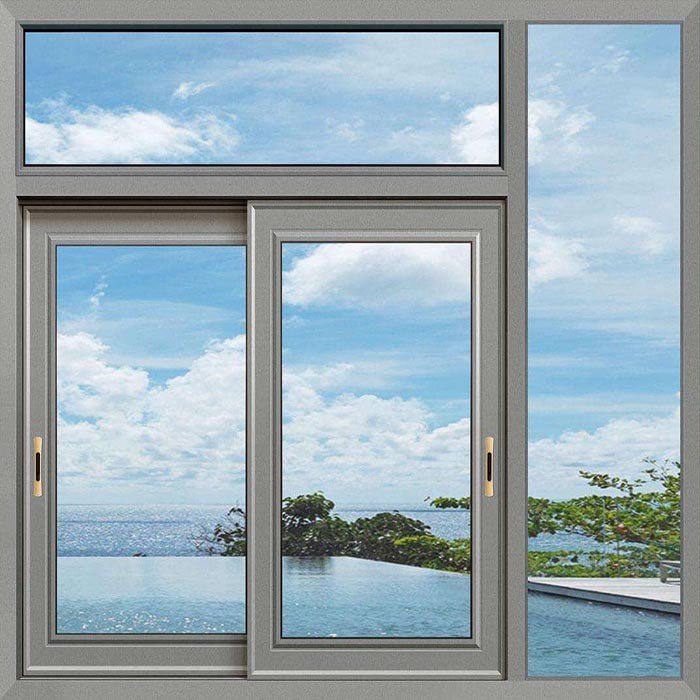Description
Enhancing Thermal Insulation The Evolution of powder coated aluminium doors and windows

Enhancing Thermal Insulation: The Evolution of doors and windows
In the quest for energy efficiency and sustainable living, the role of doors and windows in a building's envelope cannot be overstated. They are not merely passages to the outside world but also critical components in maintaining a comfortable indoor environment. The thermal insulation performance of doors and windows is paramount in reducing energy consumption and ensuring year-round comfort.
**Understanding Thermal Insulation**
Thermal insulation refers to the ability of a material to resist heat flow. In the context of doors and windows, it is the property that prevents the transfer of heat or cold from the outdoors to the indoors and vice versa. Poor insulation can lead to increased energy use for heating and cooling, higher utility bills, and discomfort for occupants.
**Key Factors in Thermal Insulation**
1. **Material Selection**: The choice of material for doors and windows plays a significant role in their thermal performance. Wood, fiberglass, and certain types of plastic have better insulation properties than metal or aluminum.
2. **Glass Technology**: Double or triple-glazed windows with low-emissivity (Low-E) coatings can significantly reduce heat transfer. Argon or krypton gas fills between panes further enhance insulation.
3. **Frame Design**: The design of the frame affects thermal performance. Frames with thermal breaks or those that are multi-chambered can reduce heat conduction.
4. **Sealing**: Proper sealing around doors and windows prevents drafts and air infiltration, which can lead to heat loss or gain.
5. **Orientation and Size**: The size and placement of windows also impact thermal performance. Larger windows allow more solar heat gain but may also lead to greater heat loss.
**Strategies for Enhancing Thermal Insulation**
1. **Upgrade to Energy-Efficient Glass**: Replacing single-pane glass with double or triple-pane options can drastically improve insulation. Look for glasses with a low U-value, which indicates lower heat transfer.
2. **Utilize Advanced Frame Technologies**: Modern frames made from composite materials or with thermal breaks can reduce heat conduction and improve overall insulation.
3. **Implement Proper Sealing Techniques**: Weatherstripping and high-quality gaskets can seal gaps and prevent air leaks, enhancing insulation.
4. **Optimize Window Orientation and Size**: South-facing windows can provide passive solar heating in the winter, while smaller windows on the north side can reduce heat loss.
5. **Incorporate Blinds, Shutters, and Curtains**: These not only provide privacy and control daylight but also add an extra layer of insulation.
6. **Use Insulated Doors**: Doors with a high insulation value, such as those made from solid wood or with a core filled with insulation material, can prevent heat transfer.
**Technological Advancements in Thermal Insulation**
1. **Smart Glass**: Dynamic glass that can change its opacity or tint in response to sunlight can reduce solar heat gain and glare, improving thermal comfort.
2. **Thermal Imaging**: Using thermal imaging cameras to identify heat leaks around doors and windows can guide targeted insulation improvements.
3. **insulated glazing Units (IGUs)**: IGUs with advanced gas fills and coatings can provide superior thermal insulation compared to traditional glass panes.
4. **Automated Insulation Systems**: Automated blinds and shutters that respond to temperature changes or solar positioning can dynamically adjust insulation levels.
**Conclusion**
Enhancing the thermal insulation performance of doors and windows is a multifaceted approach that involves material selection, design optimization, and the integration of advanced technologies. By prioritizing thermal insulation, homeowners and builders can contribute to energy conservation, reduce environmental impact, and create more comfortable living and working spaces. As the demand for sustainable building practices grows, the development of innovative solutions in door and window insulation will continue to advance, offering greater efficiency and performance.
---
This article delves into the importance of thermal insulation in doors and windows, the factors that contribute to it, and the strategies that can be employed to enhance it. It also touches on the role of technology in improving thermal performance, highlighting the potential for smart and automated systems to further optimize insulation.
| Profile | Aluminum Alloy | Thermal-break/non-thermal-break |
| Thickness | 1.4mm for windows | |
| 2.0mm for doors | ||
| Surface Treatment | Customized | |
| (Powder-coated/Anodized/ | ||
| Electrophoresis/Fluorocarbon) | ||
| Color | Customized | |
| Glass | Type | Customized |
| (Lowe/Tempered/Reflective | ||
| Float/Laminated, etc.) | ||
| Glazed | Single/Double/Triple | |
| (for cold area and cyclone area) | ||
| Thickness | Single: 5mm-12mm | |
| Double: 5mm+6A+5mm/ | ||
| 5mm+9A+5mm | ||
| 6mm+9A+6mm,etc. | ||
| Low-E Double Glazing: | ||
| 5+12A+5 glass/6+12A+6 glass etc | ||
| Laminated Glass: | ||
| 4mm+0.38pvb+4mm | ||
| 6mm+0.76pvb+6mm,etc. | ||
| Color | Customized: | |
| Clear/ Tinted | ||
| (Grey/Blue/Light Green, etc.) | ||
| Hardware | Chinese Top Brand | |
| Sealant | EPDM, Silicone Sealant | |
| Other | Mosquito net/Stainless steel screen | |
| /Inside blinds/Grid, etc. | ||
Aluminum Window Details:
Frame:


Produce Process:

 English
English Russian
Russian





